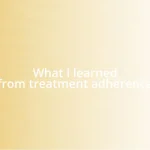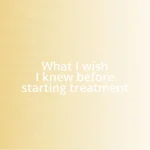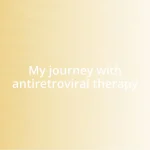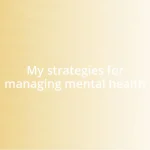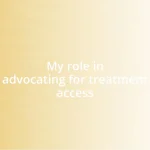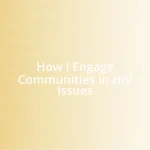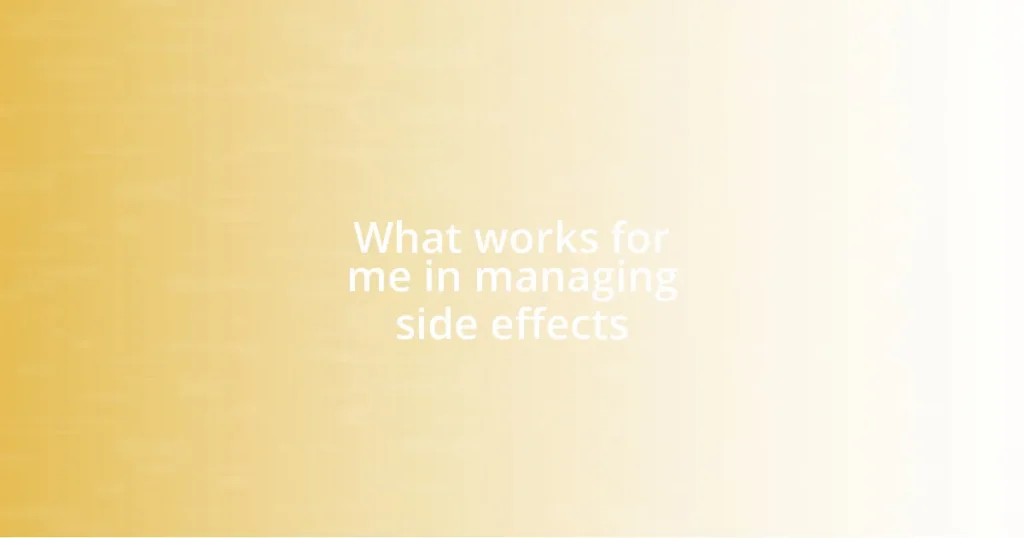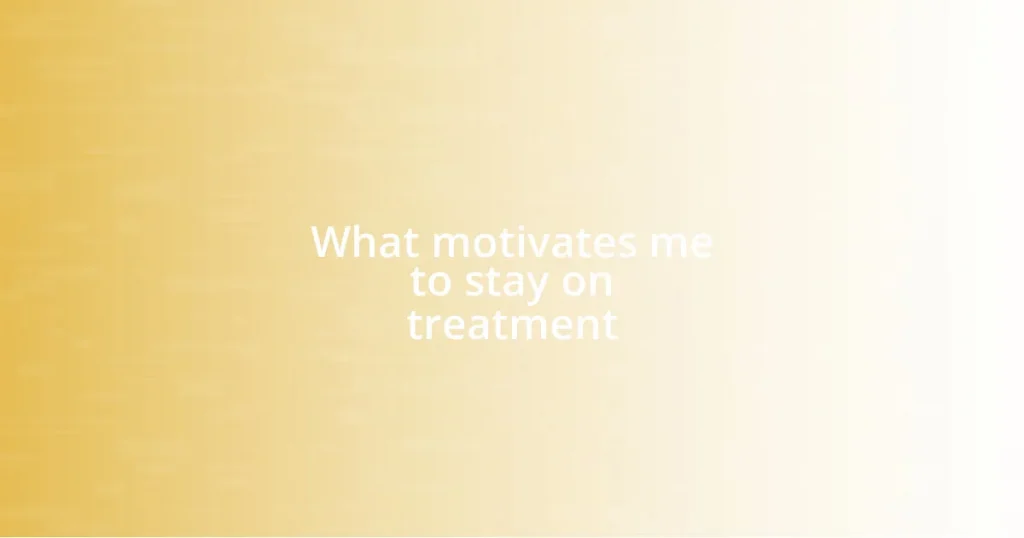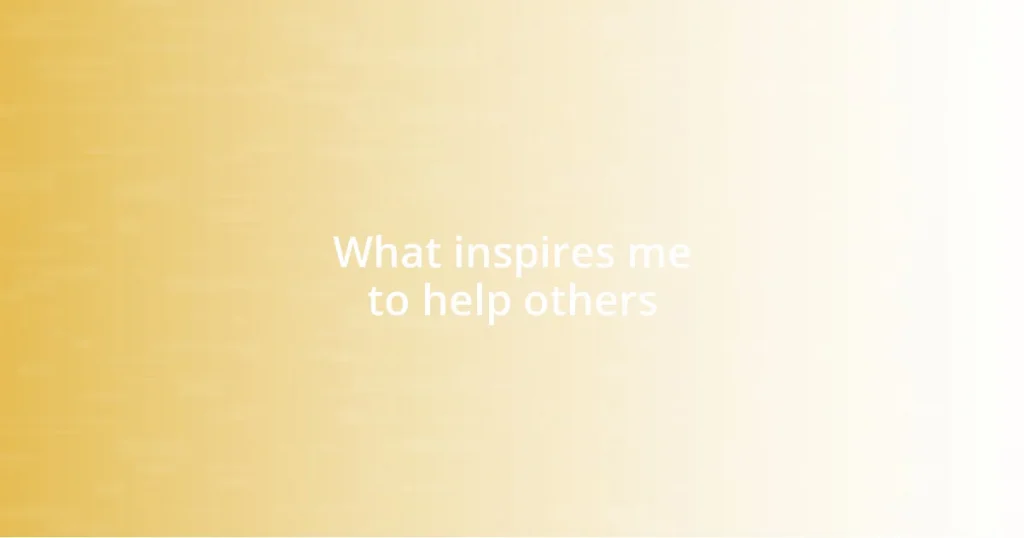Key takeaways:
- HIV awareness is essential for combating stigma and fostering understanding in communities.
- Key advocacy focuses include equitable healthcare access, education campaigns, and mental health support for those living with HIV.
- Effective educational campaigns should engage audiences through storytelling, relatable content, and interactive approaches.
- Collaboration with healthcare professionals enhances advocacy efforts by providing accurate information and destigmatizing conversations around HIV.

Understanding HIV Awareness Importance
HIV awareness is crucial not just for those living with the virus, but for society as a whole. I remember a time when a close friend of mine shared their diagnosis with me; the fear and stigma they faced were palpable. It made me realize how vital it is to educate ourselves and others about HIV to dismantle those misconceptions.
Understanding HIV awareness goes beyond knowledge; it’s about compassion and support. One evening, at a community event, I witnessed strangers come together, united by stories of hope and struggle. Seeing their vulnerability inspired me, and it struck me—how many otherwise compassionate people simply lack the information needed to make a difference in someone’s life?
It’s important to ask ourselves: what would it mean for our communities if we prioritized HIV awareness? Imagine a world where open conversations about HIV lead to fewer new infections, less discrimination, and a greater sense of belonging for those affected. I believe that by fostering understanding, we pave the way for a future that embraces education and empathy.

Identifying Key Areas for Advocacy
Identifying key areas for advocacy is essential to making a meaningful impact in the fight against HIV. For instance, access to healthcare is a critical focus. I remember visiting a local clinic and hearing from individuals struggling to find the right medications due to financial barriers. By advocating for equitable healthcare access, we can ensure that everyone, regardless of their economic situation, can receive the necessary treatment.
Furthermore, education and awareness campaigns play a pivotal role in changing perceptions about HIV. During a workshop I attended, a participant shared how learning about prevention methods transformed their understanding of the virus. This encounter illuminated for me the urgency of creating engaging educational resources that resonate with diverse communities. I firmly believe that utilizing relatable stories can dismantle stigma and inspire urgency in prevention.
Lastly, mental health support is often overlooked but is vital for those living with HIV. I recall a heartfelt conversation with a peer who felt isolated and overwhelmed by their diagnosis. This experience taught me that advocating for mental health resources is just as crucial as targeting physical health. Advocacy should aim to provide comprehensive support to help individuals lead fulfilling lives beyond their diagnosis.
| Key Areas for Advocacy | Importance |
|---|---|
| Healthcare Access | Ensures everyone has the necessary treatment regardless of economic barriers. |
| Education and Awareness | Transforms perceptions, encourages safe practices, and dismantles stigma. |
| Mental Health Support | Addresses emotional well-being, fostering a supportive community for those affected. |

Developing Educational Campaigns Effectively
Developing effective educational campaigns requires a nuanced understanding of your audience and the contexts in which they live. I once helped organize a community workshop where attendees could interact with healthcare professionals and ask questions in a safe environment. The conversations that emerged were eye-opening. I couldn’t help but notice how the simple act of creating a space for dialogue made participants feel valued and heard. This reinforced my belief that campaigns should not only deliver information but also foster genuine interaction.
To create impactful educational campaigns, consider these strategies:
- Tailor the Content: Use language and examples that resonate with specific demographics, ensuring that the material feels relatable.
- Incorporate Storytelling: Share real-life experiences or testimonials, which can bring statistics to life and foster empathy.
- Utilize Multimedia: Combine videos, infographics, and social media posts to reach a broader audience and cater to different learning styles.
- Encourage Participation: Invite community members to share their experiences, making them active contributors in the learning process.
- Evaluate and Adapt: Gather feedback after each initiative to understand what worked and what can be improved for future campaigns.
I learned through my experiences that well-designed campaigns can break barriers and significantly shift public perception.

Engaging the Community Through Events
Engaging the community through events has been one of the most rewarding aspects of my advocacy work. I recall a health fair where we set up a booth, complete with games and giveaways, all centered around HIV awareness. It was fascinating to watch how curiosity sparked conversations, breaking down walls that often loom around this topic. Isn’t it amazing how something as simple as a game can open up dialogue and lead to deeper understanding?
At another event, I organized a panel discussion featuring individuals living with HIV, sharing their stories. Seeing the audience’s reaction reminded me of the power of firsthand experiences. People leaned in, visibly moved. It made me realize that storytelling connects us on a human level and fosters empathy. I’ve learned that when we put faces to statistics, we ignite a spark that encourages others to engage and learn.
Furthermore, I often emphasize the importance of collaboration during these events. Partnering with local organizations not only amplifies our message, but it also showcases the social fabric of our community. I remember working with a local artist to create an art installation that depicted the journey of living with HIV. Watching attendees interact with the artwork sparked rich conversations that would have otherwise remained unspoken. Talk about the transformative power of community engagement!

Utilizing Social Media for Outreach
I’ve found that social media can be a game-changer in spreading awareness about HIV. When I first began using platforms like Instagram and Twitter, I was amazed at how quickly even simple posts could spark interest. I remember sharing a personal story about misconceptions surrounding HIV, and the flood of messages I received afterward was heartwarming. People were eager to learn, share their own experiences, and even ask questions they felt they couldn’t voice elsewhere. It was a humbling reminder of the potential social media holds for building a supportive community.
Beyond personal stories, I’ve seen that creating visually appealing content can make a significant impact. A few months ago, I designed a series of infographics that broke down HIV statistics and myths in an engaging way. The response was incredible—people were not only liking and sharing, but also tagging friends to spread the message further. Isn’t it powerful how a well-crafted image can reach hearts and minds far beyond our immediate circles? It’s taught me that sometimes, a compelling visual can convey complex information more effectively than words alone.
I also prioritize using interactive elements. For instance, during a recent campaign, I hosted a live Q&A session on Facebook. I was nervous at first, but to my surprise, viewers poured in with questions and comments that enriched the discussion. It highlighted for me how vital it is to create spaces for open dialogue, even on social media, where people can feel safe asking tough questions. Engaging directly with the audience can transform a one-way conversation into a vibrant exchange of ideas, fostering a deeper connection and understanding.

Collaborating with Healthcare Professionals
Collaboration with healthcare professionals has been a cornerstone of my advocacy for HIV awareness. I remember coordinating a workshop with a local clinic where healthcare providers were able to share vital information about prevention and treatment options. The energy in the room was electric—people were genuinely eager to ask questions, dispelling myths that often cloud the topic of HIV. Isn’t it fascinating how direct access to knowledgeable professionals can empower a community?
Working closely with healthcare teams also allows for the development of tailored educational resources. For instance, I once collaborated with a nurse to create a pamphlet specifically addressing the concerns of marginalized groups at risk for HIV. Our discussions opened my eyes to the obstacles they face in accessing care, and it was humbling to see how our partnership made a tangible difference. It reminded me that by merging advocacy with medical expertise, we can build trust and bridge gaps that often exist.
Moreover, I find that being present in clinical settings can significantly destigmatize the conversation around HIV. During a clinic open house, I joined health professionals in providing free screenings and consultations. It was heartwarming to witness community members engaging with both advocates and doctors in the same space. Isn’t it magical when people realize they can talk openly with a healthcare provider about their concerns? These collaborations cultivate an environment where education and compassion go hand in hand.

Measuring Advocacy Impact and Success
Measuring the impact of my advocacy efforts feels like a puzzle sometimes, but I’ve learned that collecting qualitative and quantitative data is essential. For example, I started tracking engagement metrics on my social media posts, noting how many people participated in my live sessions or shared my infographics. This data not only shows the reach of my efforts but also highlights the moments that sparked the most meaningful conversations.
I once organized a community event and asked participants to fill out feedback forms, sharing their thoughts and feelings on what they learned. The responses were eye-opening; many expressed a newfound understanding of HIV, which made all the hard work worthwhile. It’s incredible how a simple act of gathering feedback can illuminate the deeper connections my advocacy has fostered and pinpoint areas for further development.
Moreover, recognizing success in advocacy goes beyond numbers; it’s about the stories behind them. I recall a woman who approached me after one of my workshops, thanking me for giving her the tools to educate her family about HIV. That moment reinforced my belief that real change happens when knowledge empowers individuals. Isn’t it fascinating how metrics and personal stories can intertwine, creating a narrative of progress and impact?



